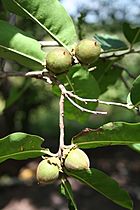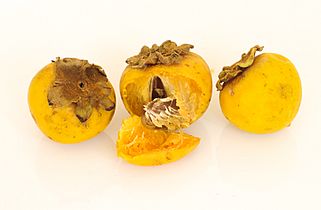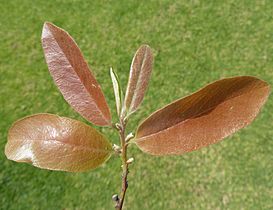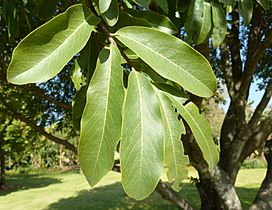Jackalberry facts for kids
Quick facts for kids Jackalberry |
|
|---|---|
 |
|
| Mature specimens on the shore of the Cuando River, Chobe N.P., Botswana | |
| Scientific classification | |
| Genus: |
Diospyros
|
| Species: |
mespiliformis
|
| Synonyms | |
|
Diospyros sabiensis Hiern |
|
The jackalberry (also called African ebony or jakkalsbessie in Afrikaans) is a big evergreen tree. It grows mostly in the savannas of Africa. Jackals really like its fruit, which is how it got its name! This tree is part of the Ebenaceae family. It is a cousin to the famous ebony tree and the tasty persimmon.
Contents
What the Jackalberry Tree Looks Like
Adult jackalberry trees usually grow to be about 4 to 6 meters (13 to 20 feet) tall. Some can even reach 25 meters (82 feet)! Their bark is dark gray and has deep cracks.
The tree has thick, dark green leaves that are shaped like an oval. Big animals like elephants and buffalo often munch on these leaves.
Flowers and Fruit
Jackalberry trees bloom during the rainy season. Their flowers are creamy white. What's cool is that male and female flowers grow on different trees. This means you need both a male and a female tree for fruit to grow!
The female trees produce fruit in the dry season. These fruits are oval-shaped and turn yellow or purple when they are ripe. They are about 2 to 3 centimeters (0.8 to 1.2 inches) wide. Many wild animals enjoy eating them. Like the marula tree, people in the Bantu communities often let jackalberry trees grow in their farms so they can collect the fruit.
Where Jackalberry Trees Live
Jackalberry trees often grow on termite mounds. They prefer deep, rich soils, but you can also find them in sandy areas of the savanna.
The tree and termites have a special relationship called mutualism. The termites help the tree by digging tunnels around its roots, which lets air get to them. In return, the tree gives the termites a safe place to live. Termites do not eat the living wood of the tree.
The jackalberry is the largest tree of its kind in southern Africa. It grows in many places, from warmer subtropical areas all the way up to tropical regions near the Sahara Desert.
Uses of the Jackalberry Tree
The jackalberry tree is very useful to both animals and people.
Tasty Fruit
The fruit of the jackalberry is a traditional food in Africa. It can help people get good nutrition and improve food security in rural areas.
Humans can eat the fruit. When it's not quite ripe, it might taste a bit like lemon and feel chalky. But when it's fully ripe, it's sweet and soft! Each fruit usually has 2 to 5 brown seeds inside.
Many people like to let the fruit dry before eating it. Dried fruits can be stored and enjoyed as a snack when fresh fruit isn't available. Sometimes, the fruit is made into jams or ground into flour. It's also often used to make beer and a strong drink called brandy.
The Ovambo people call the jackalberry fruit eenyandi. They use it to make ombike, which is their traditional alcoholic drink.
Traditional Medicine
The leaves, bark, and roots of the jackalberry tree contain something called tannin. Tannin can help stop bleeding. The roots are also sometimes eaten to help get rid of parasites in the body. They are also thought to be a traditional remedy for some skin conditions.
Strong Wood
The wood from the jackalberry tree is very strong and termites usually don't damage it. The inner part of the wood is fine-grained and tough. It's often used to make beautiful wood floors and furniture. The large trunks of the tree are also used to make canoes. The wood can be light reddish-brown or a very dark brown.
Gallery






